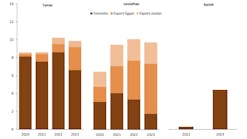A painful market downturn, stricter regulations, bad energy policy compete with technological challenges
Kevin McEvoy
Chairman
National Ocean Industries Association
CEO
Oceaneering International, Inc.
Each May, the Offshore Technology Conference draws tens of thousands of international attendees who marvel at the incredible and innovative technology our industry uses to safely develop offshore oil and gas resources, even in the deepest and most challenging environments. Technological advances made by our industry allow us to drill in deeper waters, tap deeper reservoirs, and withstand higher pressures and higher temperatures. Today, domestically produced fossil fuels account for 75% of US energy production. In recent years, however, the technological challenges facing our industry are getting heavy competition from a painful market downturn, as well as an onslaught of overly burdensome regulations and poor policy decisions as the Obama administration advances its climate-change agenda.
I was recently named Chairman of the National Ocean Industries Association (NOIA), a Washington, D.C.-based energy trade association consisting of about 300 member companies, engaged in all segments of the offshore energy business. Oceaneering International, which I lead as CEO, is a long-time member of NOIA. Formed in 1972, NOIA has always had one core mission -- to promote the opening of more of the outer continental shelf (OCS) to energy exploration and development. With nearly 87% of the OCS closed to oil and natural gas exploration and development for decades, our work has always been cut out for us.
The chances for increased offshore access looked promising in early 2015 when the Bureau of Ocean Energy Management released its 2017-2022 OCS Oil and Gas Leasing Draft Proposed Program (DPP). In addition to lease sales in the Gulf of Mexico and Alaskan Arctic, the DPP included a proposed lease sale in the Atlantic offshore Virginia, North Carolina, South Carolina, and Georgia; an area last explored in the 1980s. There is strong support for offshore oil and natural gas development from various state and local elected officials and stakeholder groups across a wide array of industries in the Atlantic states; not to mention longstanding bipartisan and bicameral support in the US Congress. Additionally, several industry polls show that a majority of Americans, as well as a majority of residents of Virginia, North Carolina, South Carolina, and Georgia, favor offshore oil and gas development.
However, in mid-March, industry hopes for increased offshore access were dashed, when the administration removed the Atlantic sale from the proposed program, citing “strong public opposition” as one of the primary reasons. From NOIA’s point of view, the administration unilaterally ignored strong public and political support for new offshore exploration in order to appease a radical and extreme minority devoted to keeping fossil fuels in the ground.
The administration also cited potential conflicts with military operations as a factor in removing the Atlantic; a dubious rationale given the fact that military and oil and gas activities have coexisted for decades in the GoM. Likewise, experience has shown that offshore development does not conflict with, but rather complements, rich tourism and fishing industries. For decades, these industries have coexisted and thrived in the GoM. Why should any of these activities prove to be less compatible in the Atlantic?
The fact is that offshore oil and gas operations are conducted safely around the world on a daily basis, while technology and safety measures continually advance. Other nations along the Atlantic basin -- including Canada, Mexico, Brazil, Greenland, Ghana, and Angola -- have recognized the economic and energy security potential of their offshore areas, and the US should do the same. By removing the Atlantic sale from the next five year leasing program, the administration has forfeited tremendous future economic benefits and risked our nation’s recently earned status as the global energy leader.
Oil and natural gas are projected to remain major sources for meeting the world’s growing energy needs for the foreseeable future. The US Energy Information Administration predicts that traditional forms of energy such as coal, oil, natural gas, and nuclear will still provide about 88% of our energy needs in 2040, even with the growth of renewable energy. To ignore the need for affordable, safe, and reliable energy in favor of the agenda of a few ill-informed radical groups would be catastrophic for the US and the world. The truth is there is no known practical substitute for carbon-based energy supply in the near or medium term that is viable either economically or in scale.
The good news is that the proposed program still includes lease sales in the Alaskan Arctic and the GoM. However, when it comes to the Arctic, the Department of the Interior (DOI) appears to be on the fence regarding the proposed sales in Cook Inlet and the Beaufort and Chukchi seas. As DOI collects public comments on the proposed program, it is considering excluding Arctic offshore areas that are important ecologically or for traditional subsistence fishing and hunting; or not holding any lease sales at all. NOIA will fight to keep the Arctic sales in the final version of the 2017-2022 OCS Leasing Program, which is expected to be released around the end of this year.
In these challenging times for our industry, NOIA and our members understand that a broad-based energy portfolio is key to maintaining our nation’s position as the global leader in energy production. Our industry is resilient, and as Chairman of NOIA, I am confident that the future will bring new opportunities for our industry to safely produce reliable and affordable oil and natural gas for American consumers, bolster the US economy, and increase domestic energy security long into the future.






